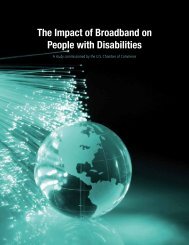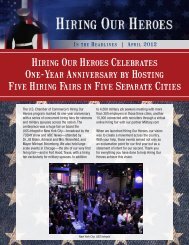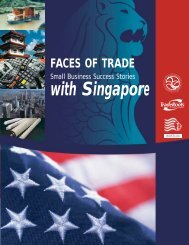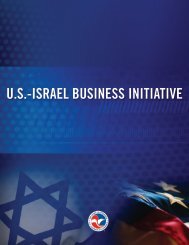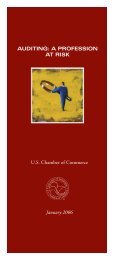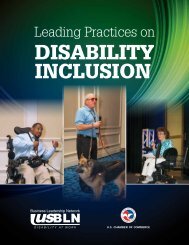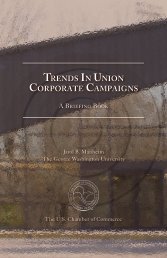[PDF] A Response by the International Organisation of Employers to ...
[PDF] A Response by the International Organisation of Employers to ...
[PDF] A Response by the International Organisation of Employers to ...
- No tags were found...
You also want an ePaper? Increase the reach of your titles
YUMPU automatically turns print PDFs into web optimized ePapers that Google loves.
INTERNATIONAL ORGANISATION OF EMPLOYERSORGANISATION INTERNATIONALE DES EMPLOYEURSORGANIZACIÓN INTERNACIONAL DE EMPLEADORESA <strong>Response</strong> <strong>by</strong> <strong>the</strong> <strong>International</strong><strong>Organisation</strong> <strong>of</strong> <strong>Employers</strong> <strong>to</strong> <strong>the</strong>Human Rights Watch Report —“A Strange Case: Violations <strong>of</strong>Workers’ Freedom <strong>of</strong> Association in <strong>the</strong>United States <strong>by</strong> EuropeanMultinational Corporations”A SPECIAL EDITION OFTHE INTERNATIONAL LABOURAND SOCIAL POLICY REVIEWGeneva, Switzerland – May 2011
Copyright © <strong>International</strong> <strong>Organisation</strong> <strong>of</strong> <strong>Employers</strong> 2011The opinions expressed in <strong>the</strong>se contributions, o<strong>the</strong>r than those written <strong>by</strong> <strong>the</strong> IOE, rest solely with <strong>the</strong>irauthors. Publication does not constitute an endorsement <strong>by</strong> <strong>the</strong> <strong>International</strong> <strong>Organisation</strong> <strong>of</strong> <strong>Employers</strong>.Although this publication is protected under copyright laws, short excerpts may be reproduced withoutauthorization on <strong>the</strong> condition that <strong>the</strong> source and/or author are acknowledged.Applications <strong>to</strong> reproduce, translate, adapt or s<strong>to</strong>re this publication in part or in whole should beaddressed <strong>to</strong> <strong>the</strong> <strong>International</strong> <strong>Organisation</strong> <strong>of</strong> <strong>Employers</strong> (IOE), 26 Chemin de Joinville, 1216 Cointrin /Geneva, Switzerland.
CONTENTSForeword ....................................................................... 1Introduction and Executive Summary <strong>of</strong> <strong>the</strong> <strong>Response</strong>................... 2A Summary <strong>of</strong> <strong>the</strong> Human Rights Watch Report........................... 4Background — <strong>International</strong> Labour Law................................... 5The Principles <strong>of</strong> Freedom <strong>of</strong> Association Under<strong>International</strong> Law .............................................................. 6The Principles <strong>of</strong> Freedom <strong>of</strong> Association in <strong>the</strong> United States . . . . . . . . . . 8Scrutiny <strong>of</strong> U.S. Law Within <strong>the</strong> Context <strong>of</strong> <strong>International</strong> Law ..........10Contrary <strong>to</strong> <strong>the</strong> Report’s Assertions, U.S. National LawConforms <strong>to</strong> <strong>the</strong> Principles <strong>of</strong> Freedom <strong>of</strong> Association asThey Are Defined <strong>International</strong>ly ...........................................11U.S. National Law Conforms <strong>to</strong> <strong>the</strong> Principles <strong>of</strong> Freedom <strong>of</strong>Association with Respect <strong>to</strong> Freedom <strong>of</strong> Expression and Opinion .....14As a Procedural Matter, <strong>the</strong> NLRA and NLRB Effectively ProtectWorkers’ Freedom <strong>of</strong> Association Rights ..................................18The Decline <strong>of</strong> Labour Unions in <strong>the</strong> United States.......................21Conclusion .....................................................................23Acknowledgments ............................................................24
1ForewordIn September 2010, Human Rights Watch, published a report entitled A Strange Case —Violation <strong>of</strong> Workers’ Freedom <strong>of</strong> Association in <strong>the</strong> United State <strong>by</strong> European MultinationalCorporations (hereinafter “Report”). The Report argues that <strong>the</strong> protections available in<strong>the</strong> United States for workers who desire <strong>to</strong> become unionized are insufficient and that<strong>the</strong> American laws are inconsistent with <strong>the</strong> protections available under internationallabour law. Relying on a series <strong>of</strong> select examples <strong>of</strong> European-based multinationals’alleged or actual violations <strong>of</strong> U.S. and international labour law, <strong>the</strong> Report contendsthat European companies operating in <strong>the</strong> United States work under a double-standardwhen compared <strong>to</strong> <strong>the</strong>ir operations at home and <strong>the</strong>ir public pronouncements in codes<strong>of</strong> conduct and corporate statements <strong>of</strong> policy.This paper is a response <strong>by</strong> <strong>the</strong> <strong>International</strong> <strong>Organisation</strong> <strong>of</strong> <strong>Employers</strong> (“IOE”) <strong>to</strong>some <strong>of</strong> <strong>the</strong> critical flaws contained in <strong>the</strong> Report and its analysis. This <strong>Response</strong> isdesigned <strong>to</strong> <strong>of</strong>fer a broader and more complete perspective on this critical debate.The foregoing text will identify and explore misleading aspects <strong>of</strong> <strong>the</strong> Report. Theanalyses in this <strong>Response</strong> relied upon publicly available information, including <strong>the</strong>responses from <strong>the</strong> companies featured in <strong>the</strong> Report, and <strong>the</strong> IOE’s own review andunderstanding <strong>of</strong> <strong>the</strong> relevant authorities.To be clear, <strong>the</strong> IOE and <strong>the</strong> employer associations and companies it represents do notcondone violations <strong>of</strong> national law and practice. Enterprises that fail <strong>to</strong> follow nationallaw should be sanctioned in accordance with that law. That said, isolated transgressionssuch as those presented in <strong>the</strong> Report, particularly where <strong>the</strong>y have merely been allegedand not proven, do not justify broad assertions regarding claimed deficiencies in U.S.law. Moreover, <strong>the</strong>re exists no support for <strong>the</strong> notion that companies should adhere <strong>to</strong>higher standards than those set out under applicable national law and practice wherethat national law conforms <strong>to</strong> <strong>the</strong> basic principles <strong>of</strong> international law. Any arguments<strong>to</strong> <strong>the</strong> contrary, must be summarily rejected.Ultimately, this critical and complex debate cannot be conducted solely from oneperspective. Ra<strong>the</strong>r, it requires that <strong>the</strong>re be balance. As such, this <strong>Response</strong> willserve <strong>to</strong> challenge certain conclusions and arguments contained in <strong>the</strong> Report, and <strong>to</strong>provide those interested in this debate a viewpoint that <strong>the</strong> Report does not <strong>of</strong>fer.Brent Wil<strong>to</strong>nDeputy Secretary GeneralGeneva, Switzerland
A <strong>Response</strong> <strong>by</strong> <strong>the</strong> <strong>International</strong> <strong>Organisation</strong> <strong>of</strong> <strong>Employers</strong> 3Second, <strong>the</strong> Report fur<strong>the</strong>rs <strong>the</strong> argument among trade unions that silence withrespect <strong>to</strong> union organizing is what is <strong>to</strong> be expected <strong>of</strong> employers if <strong>the</strong>y are <strong>to</strong> beconsidered in compliance with <strong>the</strong> principles <strong>of</strong> international law. Yet, <strong>the</strong> principles<strong>of</strong> freedom <strong>of</strong> association as defined at <strong>the</strong> international level promote <strong>the</strong> freeexchange <strong>of</strong> information and ideas regardless <strong>of</strong> <strong>the</strong>ir source or affinity. Such freedom<strong>of</strong> expression and opinion is encouraged so long as its manifestation does not interferewith an employee’s free choice. Just because an employer’s origin is Europe, or it haspublicly stated support for instruments that incorporate international principles <strong>of</strong>labour law, does not mean that <strong>the</strong> employer forfeits its national rights <strong>to</strong> freedom<strong>of</strong> expression and opinion. In fact, <strong>to</strong> deny employees access <strong>to</strong> relevant informationabout unionization would serve <strong>to</strong> violate <strong>the</strong> very principles <strong>of</strong> international law <strong>the</strong>Report seeks <strong>to</strong> promote.Finally, <strong>the</strong> Report is premised upon <strong>the</strong> notion that American workers necessarilywant or feel a need <strong>to</strong> be represented <strong>by</strong> a trade union. Trade union membership in<strong>the</strong> United States has declined steadily for <strong>the</strong> past 50 years. The reasons behind thisdecline vary. Many have nothing <strong>to</strong> do with employer hostility or alleged deficienciesin U.S. law. In fact polling data suggests that many American workers are satisfied with<strong>the</strong>ir employer or <strong>the</strong>ir working conditions, and simply do not wish <strong>to</strong> be represented<strong>by</strong> a labour union. The preservation <strong>of</strong> that choice is what <strong>the</strong> principles <strong>of</strong> freedom <strong>of</strong>association exist <strong>to</strong> fur<strong>the</strong>r and protect. Just because <strong>the</strong> workers featured in <strong>the</strong> casescited in <strong>the</strong> Report did not choose <strong>to</strong> be represented <strong>by</strong> a labour union does not mean<strong>the</strong> decision was <strong>the</strong> result <strong>of</strong> unlawful or inappropriate actions <strong>by</strong> an employer. A trueunderstanding <strong>of</strong> this issue requires meaningful discussion <strong>of</strong> all <strong>of</strong> <strong>the</strong> reasons <strong>the</strong>workers rejected union representation. The risk <strong>of</strong> not engaging in such discussioncreates <strong>the</strong> far greater risk <strong>of</strong> misrepresenting <strong>the</strong> true sentiments <strong>of</strong> employees.
4A <strong>Response</strong> <strong>by</strong> <strong>the</strong> <strong>International</strong> <strong>Organisation</strong> <strong>of</strong> <strong>Employers</strong>A Summary <strong>of</strong> <strong>the</strong> Human Rights Watch ReportThe Human Rights Watch Report provides a summary <strong>of</strong> U.S. and international labourlaw standards that cover <strong>the</strong> principles <strong>of</strong> freedom <strong>of</strong> association. 3 It details <strong>the</strong> relevantconventions, principles and mechanisms that constitute international labour standardsand lists examples <strong>of</strong> interference with <strong>the</strong> principles <strong>of</strong> freedom <strong>of</strong> association as it hasbeen defined at <strong>the</strong> international level. 4 It <strong>the</strong>n summarizes <strong>the</strong> author’s opinion withrespect <strong>to</strong> freedom <strong>of</strong> association under U.S. law. 5Following a brief description <strong>of</strong> U.S. law, <strong>the</strong> Report outlines how <strong>the</strong> authors believea number <strong>of</strong> aspects <strong>of</strong> <strong>the</strong> country’s labour laws fall short <strong>of</strong> international standards. 6Specifically, it cites areas where U.S. laws have been criticized <strong>by</strong> <strong>the</strong> ILO. 7 It alsocriticizes <strong>the</strong> secret-ballot election process under <strong>the</strong> NLRA, and <strong>the</strong> enforcementmechanisms available under U.S. law. 8The Report dedicates a majority <strong>of</strong> its text <strong>to</strong> detailing examples <strong>of</strong> how a handful<strong>of</strong> European-based multinationals 9 have made public statements <strong>of</strong> support forinternational labour standards, and how those very companies have allegedly violatedinternational or U.S. labour laws in <strong>the</strong>ir activities in <strong>the</strong> United States. To support itsarguments, <strong>the</strong> Report cites a mix <strong>of</strong> public records, employee interviews, newspaperand o<strong>the</strong>r accounts. The employers featured in <strong>the</strong> Report were given an opportunity<strong>to</strong> provide <strong>the</strong>ir position, and responses received were cited in <strong>the</strong> Report and postedon <strong>the</strong> Human Rights Watch website.As a conclusion, <strong>the</strong> Report <strong>of</strong>fers recommendations <strong>to</strong> four separate audiences. ForEuropean-based multinational corporations operating in <strong>the</strong> United States, <strong>the</strong> Reportasks <strong>the</strong>m <strong>to</strong> create “rigorous” mechanisms where<strong>by</strong> <strong>the</strong>ir U.S. operations could beaudited for labour law compliance, <strong>to</strong> become party <strong>to</strong> framework agreements withappropriate global union federations, and <strong>to</strong> consider working with industry-basedrepresentative groups that mirror <strong>the</strong> “works council” model seen throughout WesternEurope. For <strong>the</strong> U.S. Government, <strong>the</strong> Report asks that it ratify ILO Conventions 87and 98 and pass a host <strong>of</strong> legislation that <strong>the</strong> authors contend would rectify <strong>the</strong> allegedshortcomings in U.S. labour law described in <strong>the</strong> Report. The Report seeks <strong>to</strong> have<strong>the</strong> European Commission and European Governments place greater scrutiny on <strong>the</strong>operations <strong>of</strong> European-based corporations in <strong>the</strong> United States and <strong>to</strong> pass legislationmandating that <strong>the</strong>ir corporations’ operations abroad comply with internationalprinciples <strong>of</strong> freedom <strong>of</strong> association. Finally, it asks <strong>the</strong> Organization for EconomicCooperation and Development (“OECD”) <strong>to</strong> refine and enhance its complaintprocedure under <strong>the</strong> OECD Guidelines for Multinational Enterprises. 103 Report, at pp. 7-16.4 Report, at pp. 8-9.5 Report, at pp. 11-13.6 Report. at pp. 11-16.7 Report, at pp. 11-13.8 Report, at pp. 13-16.9 It is not clear from <strong>the</strong> Report’s methodology how its authors selected <strong>the</strong> companies featured in <strong>the</strong> Report.10 It should also be noted that in <strong>the</strong> 2011 revisions <strong>to</strong> <strong>the</strong> OECD Guidelines, <strong>the</strong> OECD did not follow <strong>the</strong>recommendations <strong>of</strong> <strong>the</strong> Human Rights Watch Report on this point.
A <strong>Response</strong> <strong>by</strong> <strong>the</strong> <strong>International</strong> <strong>Organisation</strong> <strong>of</strong> <strong>Employers</strong> 5Background — <strong>International</strong> Labour LawThe globalization <strong>of</strong> employers and <strong>the</strong> corresponding globalization <strong>of</strong> labourorganizations, have placed an added importance on <strong>the</strong> true understanding <strong>of</strong>international law and international labour standards. Unfortunately, <strong>the</strong>re is amisperception <strong>of</strong> what “international law” and “international labour standards” are,and because <strong>of</strong> that misperception, <strong>the</strong>se concepts are frequently misused.“<strong>International</strong> labour standards” and “international law” refer <strong>to</strong> a variety <strong>of</strong>conventions, principles and mechanisms developed <strong>by</strong> international organizations andin particular <strong>the</strong> <strong>International</strong> Labour Organization (“ILO”). These standards exist<strong>to</strong> guide and <strong>to</strong> influence governments in <strong>the</strong> formulation <strong>of</strong> national law and practice.This guidance serves <strong>to</strong> protect <strong>the</strong> basic rights <strong>of</strong> workers, but in a way that takes in<strong>to</strong>consideration <strong>the</strong> unique cultures, traditions and social dialogue <strong>of</strong> each nation thatapplies <strong>the</strong>m. <strong>International</strong> labour standards do not define a uniform path for everynation <strong>to</strong> follow. Ra<strong>the</strong>r, <strong>the</strong>y account for <strong>the</strong> fact that an acceptable approach inone country, may contradict cultural traditions or economic norms in ano<strong>the</strong>r. Thisframework emphasizes <strong>the</strong> fact that <strong>the</strong>re is no singular way <strong>to</strong> do things.Contrary <strong>to</strong> common misconception, international labour standards do not createobligations that directly apply <strong>to</strong> employers. They establish a framework for <strong>the</strong>development <strong>of</strong> laws, and those laws establish a framework for employer behaviour.To <strong>the</strong> extent national law and practice conform <strong>to</strong> international labour standards, anemployer cannot be accused <strong>of</strong> disregarding <strong>the</strong>m. Moreover, no one can justifiablycondemn an employer for operating under a double standard where it complies withnational laws that differ from one country <strong>to</strong> <strong>the</strong> next. Different countries requiredifferent approaches <strong>to</strong> <strong>the</strong> same issue. In <strong>the</strong> end, so long as a nation’s laws fit within<strong>the</strong> parameters defined <strong>by</strong> international labour standards, compliance with those lawsis all that is required.
6A <strong>Response</strong> <strong>by</strong> <strong>the</strong> <strong>International</strong> <strong>Organisation</strong> <strong>of</strong> <strong>Employers</strong>The Principles <strong>of</strong> Freedom <strong>of</strong> Association Under<strong>International</strong> LawThe principles <strong>of</strong> freedom <strong>of</strong> association as <strong>the</strong>y are defined at <strong>the</strong> international levelappear in a variety <strong>of</strong> international instruments. Article 20 <strong>of</strong> <strong>the</strong> United Nations’Universal Declaration <strong>of</strong> Human Rights provides for <strong>the</strong> right <strong>to</strong> freedom <strong>of</strong> association,and <strong>the</strong> corresponding right not <strong>to</strong> associate. 11 Freedom <strong>of</strong> association and <strong>the</strong> right <strong>to</strong>collective bargaining are corners<strong>to</strong>ne principles <strong>of</strong> <strong>the</strong> ILO. 12 Two ILO Conventionsgovern <strong>the</strong> basic principles <strong>of</strong> freedom <strong>of</strong> association and <strong>the</strong> right <strong>to</strong> collectivebargaining as <strong>the</strong>y are defined at <strong>the</strong> international level: Conventions 87 and 98.Convention 87, Freedom <strong>of</strong> Association and Protection <strong>of</strong> <strong>the</strong> Right <strong>to</strong> Organise,was adopted in 1948, 13 and focuses on <strong>the</strong> rights <strong>of</strong> workers <strong>to</strong> form and join labourorganizations freely. 14 Article II <strong>of</strong> Convention 87 provides that “[w]orkers andemployers, without distinction whatsoever, shall have <strong>the</strong> right <strong>to</strong> establish and,subject only <strong>to</strong> <strong>the</strong> rules <strong>of</strong> <strong>the</strong> organization concerned, <strong>to</strong> join organizations <strong>of</strong> <strong>the</strong>irown choosing without previous authorisation.” 15Convention 98, Right <strong>to</strong> Organise and Collective Bargaining Convention, wasadopted in 1949, 16 and relates <strong>to</strong> protections <strong>of</strong> workers who seek representation and<strong>the</strong> right <strong>to</strong> engage in collective bargaining. 17 Article IV <strong>of</strong> Convention 98 providesthat “[m]easures appropriate <strong>to</strong> national conditions shall be taken, where necessary<strong>to</strong> encourage and promote <strong>the</strong> full development and utilization <strong>of</strong> machinery forvoluntary negotiation between employers or employers’ organizations and workers’organizations, with a view <strong>to</strong> <strong>the</strong> regulation <strong>of</strong> terms and conditions <strong>of</strong> employment <strong>by</strong>means <strong>of</strong> collective agreements.” 1811 U.N. UNIVERSAL DECLARATION OF HUMAN RIGHTS Art. XX (1948).12 The ILO Constitution mentions <strong>the</strong> freedom <strong>of</strong> association in its preamble. In relevant part, it states:“And whereas conditions <strong>of</strong> labor exist involving such injustice hardship and privation <strong>to</strong> large numbers<strong>of</strong> people as <strong>to</strong> produce unrest so great that <strong>the</strong> peace and harmony <strong>of</strong> <strong>the</strong> world are imperilled; and animprovement <strong>of</strong> those conditions is urgently required; as, for example, <strong>by</strong> … recognition <strong>of</strong> <strong>the</strong> principle<strong>of</strong> freedom <strong>of</strong> association …” U.N. ILO CONST. pmbl., available at http://www.ilo.org/ilolex/english/iloconst.htm (last visited May 3, 2011). ILO Conventions apply <strong>to</strong> member nations that have ratified <strong>the</strong>m.Article 20 <strong>of</strong> <strong>the</strong> ILO Constitution governs <strong>the</strong> registration <strong>of</strong> Conventions <strong>by</strong> <strong>the</strong> ILO with <strong>the</strong> UnitedNations. The text reads, “[a]ny Convention so ratified shall be communicated <strong>by</strong> <strong>the</strong> Direc<strong>to</strong>r-General<strong>of</strong> <strong>the</strong> <strong>International</strong> Labour Office <strong>to</strong> <strong>the</strong> Secretary-General <strong>of</strong> <strong>the</strong> United Nations for registration inaccordance with <strong>the</strong> provisions <strong>of</strong> article 102 <strong>of</strong> <strong>the</strong> Charter <strong>of</strong> <strong>the</strong> United Nations but shall only be bindingupon <strong>the</strong> Members which ratify it.” ILO CONST. Art. XX. A Convention is an instrument <strong>of</strong> <strong>the</strong> ILOcreated <strong>by</strong> <strong>the</strong> ILO Conference and ratified <strong>by</strong> member states. U.N. ILO CONST. Art. XIX. The principle<strong>of</strong> freedom <strong>of</strong> association is also found in <strong>the</strong> 1998 Declaration on Fundamental Principles and Rights atWork which apply <strong>to</strong> ILO member states as “principles” <strong>to</strong> be realized even if <strong>the</strong>y have not ratified <strong>the</strong>Conventions from which <strong>the</strong> principles are drawn.13 U.N. ILO, Convention No. 87 (1948).14 Id.15 Id., at Art. II.16 U.N. ILO, Convention No. 98 (1949).17 Id.18 Id. at Art. IV.
A <strong>Response</strong> <strong>by</strong> <strong>the</strong> <strong>International</strong> <strong>Organisation</strong> <strong>of</strong> <strong>Employers</strong> 7In addition <strong>to</strong> <strong>the</strong> ILO Conventions, <strong>the</strong> international commitment <strong>to</strong> <strong>the</strong> principles<strong>of</strong> freedom <strong>of</strong> association appears in <strong>the</strong> ILO’s 1998 Declaration on FundamentalPrinciples and Rights at Work (“1998 Declaration”). The 1998 Declaration was adoptedas a means <strong>to</strong> guide every member nation <strong>of</strong> <strong>the</strong> ILO in its respect for labour rightssolely <strong>by</strong> virtue <strong>of</strong> membership in <strong>the</strong> ILO, irrespective <strong>of</strong> whe<strong>the</strong>r a nation has ratifieda particular convention. 19 The 1998 Declaration sets forth four core principles <strong>of</strong>international labour law, <strong>the</strong> first <strong>of</strong> which is “freedom <strong>of</strong> association and <strong>the</strong> effectiverecognition <strong>of</strong> <strong>the</strong> right <strong>to</strong> collective bargaining.” 20As a means <strong>to</strong> examine a government’s adherence <strong>to</strong> <strong>the</strong> principles <strong>of</strong> freedom <strong>of</strong>association and collective bargaining at <strong>the</strong> international level, <strong>the</strong> Governing Body<strong>of</strong> <strong>the</strong> ILO established a separate Committee on Freedom <strong>of</strong> Association (“CFA” or“Committee”) “for <strong>the</strong> purpose <strong>of</strong> examining complaints about violations <strong>of</strong> freedom<strong>of</strong> association, whe<strong>the</strong>r or not <strong>the</strong> country concerned had ratified <strong>the</strong> relevantconventions.” 21 The CFA’s stated purpose is “not <strong>to</strong> blame or punish anyone, but ra<strong>the</strong>r<strong>to</strong> engage in a constructive tripartite dialogue <strong>to</strong> promote respect for trade union rightsin law and practice.” 22 <strong>Employers</strong>’ or workers’ organizations may bring a complaintagainst any member state where <strong>the</strong>y believe <strong>the</strong> principles <strong>of</strong> freedom <strong>of</strong> associationare not being respected. 23Over <strong>the</strong> years, <strong>the</strong> CFA has examined thousands <strong>of</strong> cases and developed a substantialbody <strong>of</strong> recommendations upon which it relies <strong>to</strong> review <strong>the</strong> principles <strong>of</strong> freedom<strong>of</strong> association when examining new complaints. 24 CFA case examinations are notbinding law. Ra<strong>the</strong>r, <strong>the</strong>y are recommendations <strong>to</strong> states which are “intended as a <strong>to</strong>ol<strong>to</strong> guide reflection relating <strong>to</strong> <strong>the</strong> policies and actions <strong>to</strong> be adopted so as <strong>to</strong> ensure <strong>the</strong>fundamental principles <strong>of</strong> freedom <strong>of</strong> association.” 25 Even so, <strong>the</strong>y serve as guidance on<strong>the</strong> principles <strong>of</strong> freedom <strong>of</strong> association and <strong>the</strong> right <strong>to</strong> collective bargaining as <strong>the</strong>yare defined at <strong>the</strong> international level.19 U.N. ILO, Universal Declaration on Fundamental Principles and Rights at Work (1998), available athttp://www.ilo.org/declaration/<strong>the</strong>declaration/textdeclaration/lang--en/index.htm (last visited May 3,2011).20 Id. The o<strong>the</strong>r three areas include <strong>the</strong> elimination <strong>of</strong> forced labor, <strong>the</strong> abolition <strong>of</strong> child labor and <strong>the</strong>elimination <strong>of</strong> discrimination in employment and occupation.21 The ILO describes <strong>the</strong> Committee On Freedom <strong>of</strong> Association in this manner on its website. See htt p://www.ilo.org/global/standards/applying-and-promoting-international-labour-standards/committee-onfreedom-<strong>of</strong>-association/lang--en/index.htm(last visited May 3, 2011).22 Freedom <strong>of</strong> Association — Digest <strong>of</strong> Decisions and Principles <strong>of</strong> <strong>the</strong> Freedom <strong>of</strong> Association Committee<strong>of</strong> <strong>the</strong> Governing Body <strong>of</strong> <strong>the</strong> ILO, 2006 DIGEST, 4, available at The 2006 CFA Digest <strong>of</strong> Decisions canbe found at http://www.ilo.org/global/standards/information-resources-and-publications/publications/WCMS_090632/lang--en/index.htm (last visited May 3, 2011) (hereinafter “2006 Digest”).23 Id. at Annex I, p. 235, 31.24 Id. at Introduction, p. 3. See also, http://www.ilo.org/ilolex/english/cocaselistE.htm (last visited May 3,2010).25 Id. at Preliminary Remarks, p. 5.
A <strong>Response</strong> <strong>by</strong> <strong>the</strong> <strong>International</strong> <strong>Organisation</strong> <strong>of</strong> <strong>Employers</strong> 9At <strong>the</strong> heart <strong>of</strong> <strong>the</strong> NLRA are <strong>the</strong> Section 7 rights which <strong>the</strong> Report characterizes as“a ringing affirmation <strong>of</strong> workers’ freedom <strong>of</strong> association.” 32 Section 7 <strong>of</strong> <strong>the</strong> NLRAprovides that “[e]mployees shall have <strong>the</strong> right <strong>to</strong> self-organization, <strong>to</strong> form, join orassist labour organizations, <strong>to</strong> bargain collectively through representatives <strong>of</strong> <strong>the</strong>irown choosing, and <strong>to</strong> engage in o<strong>the</strong>r concerted activities for <strong>the</strong> purpose <strong>of</strong> collectivebargaining or o<strong>the</strong>r mutual aid or protection, and shall also have <strong>the</strong> right <strong>to</strong> refrainfrom any or all such activities.” 33 Often overlooked is <strong>the</strong> fact that Section 7 rights applyequally <strong>to</strong> those employees who do not wish <strong>to</strong> be represented <strong>by</strong> a labour union. 3432 Report, at p. 11.33 29 U.S.C. § 157.34 Id. § 158(a)(3), (b)(1)(A).
A <strong>Response</strong> <strong>by</strong> <strong>the</strong> <strong>International</strong> <strong>Organisation</strong> <strong>of</strong> <strong>Employers</strong> 13<strong>the</strong> manner in which employers can have individual meetings with employees abouta union organizing drive, regardless <strong>of</strong> what is actually said, as a means <strong>of</strong> avoidingunlawful interference with employees’ rights <strong>to</strong> organize. 52 American trade unionsare also pioneers in <strong>the</strong> field <strong>of</strong> disseminating messages through social media usingwebsites, Facebook pages and o<strong>the</strong>r forums. The <strong>to</strong>ols available <strong>to</strong> access prospectivemembers are significant, and demonstrate that <strong>the</strong> degree <strong>of</strong> employee access <strong>to</strong>labour unions in <strong>the</strong> U.S. is far more consistent with international law than <strong>the</strong>Report suggests.52 See, e.g., Economic Mach. Co., 111 NLRB 947, 949 (1955) (“<strong>the</strong> technique <strong>of</strong> calling <strong>the</strong> employees in<strong>to</strong> <strong>the</strong>Employer's <strong>of</strong>fice individually <strong>to</strong> urge <strong>the</strong>m <strong>to</strong> reject <strong>the</strong> Union is, in itself, conduct calculated <strong>to</strong> interferewith <strong>the</strong>ir free choice in <strong>the</strong> election. This is so, regardless <strong>of</strong> <strong>the</strong> noncoercive tenor <strong>of</strong> an employer's actualremarks.”)
14A <strong>Response</strong> <strong>by</strong> <strong>the</strong> <strong>International</strong> <strong>Organisation</strong> <strong>of</strong> <strong>Employers</strong>U.S. National Law Conforms <strong>to</strong> <strong>the</strong> Principles <strong>of</strong> Freedom <strong>of</strong>Association with Respect <strong>to</strong> Freedom <strong>of</strong> Expressionand OpinionIn <strong>the</strong> context <strong>of</strong> a unionization effort, U.S. law also provides a comprehensivedefinition <strong>of</strong> what statements <strong>by</strong> an employer constitute “interference,” whe<strong>the</strong>r suchstatements occur during a meeting with employees or in ano<strong>the</strong>r setting. In <strong>the</strong> U.S.,an extensive and nuanced body <strong>of</strong> authority regulates employer speech, and prohibitssuch interference. The NLRB and U.S. courts have consistently qualified an employer’sright 53 <strong>to</strong> express its opinion during a unionization effort <strong>to</strong> ensure that employees’rights are not prejudiced. 54 The restrictions on employer expression exist <strong>to</strong> ensure thatemployees may choose freely whe<strong>the</strong>r <strong>to</strong> be represented <strong>by</strong> a union.U.S. labour law’s restrictions on employer speech and conduct that interferes wi<strong>the</strong>mployee freedom <strong>of</strong> association rights mirror <strong>the</strong> prohibitions prescribed <strong>by</strong>international law. The trade union movement exists in large part because <strong>of</strong> <strong>the</strong> right<strong>to</strong> freedom <strong>of</strong> expression and opinion. At <strong>the</strong> international level, <strong>the</strong> boundaries <strong>of</strong> thisright had been defined <strong>by</strong> complaint examinations involving trade unions and allegedsuppression <strong>of</strong> expression and opinion in support <strong>of</strong> <strong>the</strong>m. 55 In May 2010 <strong>the</strong> CFAendorsed an employer’s right <strong>to</strong> free expression and opinion. 56 CFA Case No. 2683involved <strong>the</strong> United States, and <strong>the</strong> decision confirmed that employers have a rightunder international law <strong>to</strong> freedom <strong>of</strong> expression and opinion in <strong>the</strong> context <strong>of</strong> a unionorganizing effort. 57In Case No. 2683, <strong>the</strong> complaint introduced evidence <strong>of</strong> employer communications <strong>to</strong>employees designed <strong>to</strong> fur<strong>the</strong>r <strong>the</strong> employer’s position that <strong>the</strong> employees should reject<strong>the</strong> union as <strong>the</strong>ir bargaining representative. It characterized <strong>the</strong> employer’s conductas an “aggressive and sustained anti-union campaign <strong>to</strong> suppress voter turnout in <strong>the</strong>union election and interfere with <strong>the</strong>ir workers’ right <strong>to</strong> organize.” 58 Among o<strong>the</strong>rthings, <strong>the</strong> complaint claimed that <strong>the</strong> employer “saturated” <strong>the</strong> workplace with “anoverwhelming anti-union message… designed <strong>to</strong> inundate employees with anti-union53 Under U.S. law, an employer’s right <strong>to</strong> express its opinions during an organizing drive are embodied inSection 8(c) <strong>of</strong> <strong>the</strong> NLRA.54 Gissel Packing Co., 395 U.S. 575, 617 (1969). “Any assessment <strong>of</strong> <strong>the</strong> precise scope <strong>of</strong> employer expression,<strong>of</strong> course, must be made in <strong>the</strong> context <strong>of</strong> its labor relations setting. Thus, an employer's rights canno<strong>to</strong>utweigh <strong>the</strong> equal rights <strong>of</strong> <strong>the</strong> employees <strong>to</strong> associate freely . . . And any balancing <strong>of</strong> those rights musttake in<strong>to</strong> account <strong>the</strong> economic dependence <strong>of</strong> <strong>the</strong> employees on <strong>the</strong>ir employers, and <strong>the</strong> necessarytendency <strong>of</strong> <strong>the</strong> former, because <strong>of</strong> that relationship, <strong>to</strong> pick up intended implications <strong>of</strong> <strong>the</strong> latter thatmight be more readily dismissed <strong>by</strong> a more disinterested ear. Stating <strong>the</strong>se obvious principles is butano<strong>the</strong>r way <strong>of</strong> recognizing that what is basically at stake is <strong>the</strong> establishment <strong>of</strong> a non-permanent, limitedrelationship between <strong>the</strong> employer, his economically dependent employee and his union agent, not <strong>the</strong>election <strong>of</strong> legisla<strong>to</strong>rs or <strong>the</strong> enactment <strong>of</strong> legislation where<strong>by</strong> that relationship is ultimately defined andwhere <strong>the</strong> independent voter may be freer <strong>to</strong> listen more objectively and employers as a class freer <strong>to</strong> talk.”55 2006 Digest, at 154-159.56 U.N. ILOCFA 357th Rep., Case No. 2683, 584-85, United States (2010). It is, however, not <strong>the</strong> onlyCFA pronouncement endorsing <strong>the</strong> notion <strong>of</strong> employers’ freedom <strong>of</strong> speech under international labor law.See e.g., U.N. ILOCFA 356th Rep. Case No. 2654, 381, Canada (2009); U.N. ILOCFA, 350th Rep., CaseNo. 2254, 1592(g), 1655, Venezuela (2003); U.N. ILOCFA, 331st Rep., Case No. 2220, 576, Kenya(2002); U.N. ILOCFA, 216th Rep., Case No. 1084, 36, Nicaragua (1981).57 U.N. ILOCFA, 357th Rep., Case No. 2683, United States (2010).58 Id. at 451, 457, 464.
A <strong>Response</strong> <strong>by</strong> <strong>the</strong> <strong>International</strong> <strong>Organisation</strong> <strong>of</strong> <strong>Employers</strong> 15messages and misleading information.” 59 The U.S. labour union involved had arguedthis position before <strong>the</strong> national authorities, which concluded <strong>the</strong> employer’s conductdid not amount <strong>to</strong> unlawful interference.The CFA refused <strong>to</strong> condemn <strong>the</strong> voting procedure under national labour law, or <strong>the</strong>employer’s campaign statements. 60 In its conclusions, <strong>the</strong> CFA noted that “<strong>the</strong> nationalprocess did not find interference with freedom <strong>of</strong> association.” 61 Had <strong>the</strong> CFA disagreedwith that conclusion, it would have so stated. 62Case No. 2683 demonstrates that freedom <strong>of</strong> expression and opinion are fundamentalrights under international law irrespective <strong>of</strong> <strong>the</strong>ir origin or content. The complaint wasan endorsement <strong>of</strong> <strong>the</strong> approach under U.S. law <strong>to</strong> determine whe<strong>the</strong>r employer speechamounts <strong>to</strong> interference. “While having stressed <strong>the</strong> importance which it attaches t<strong>of</strong>reedom <strong>of</strong> expression as a fundamental corollary <strong>to</strong> freedom <strong>of</strong> association and <strong>the</strong>exercise <strong>of</strong> trade union rights on numerous occasions, <strong>the</strong> Committee also considersthat <strong>the</strong>y must not become competing rights, one aimed at eliminating <strong>the</strong> o<strong>the</strong>r.” 63The Committee went on <strong>to</strong> write that “providing all relevant ballot information,including how <strong>to</strong> vote against a union, would be acceptable as part <strong>of</strong> <strong>the</strong> process <strong>of</strong> acertification election,” but an employer’s active participation in a way that interfereswith an employee’s exercise <strong>of</strong> free choice would be a violation <strong>of</strong> <strong>the</strong> principles <strong>of</strong>freedom <strong>of</strong> association. 64Even more, <strong>the</strong> CFA in Case No. 2683 explained that <strong>the</strong> boundaries betweenpermissible employer speech and impermissible employer interference underinternational law are <strong>to</strong> be defined <strong>by</strong> national legislation. 65 In support <strong>of</strong> thisproposition, <strong>the</strong> CFA cited a case arising out <strong>of</strong> Canada, 66 in which it found Canadianprovincial legislation <strong>to</strong> be compatible with <strong>the</strong> principles <strong>of</strong> freedom <strong>of</strong> associationas defined at <strong>the</strong> international level because <strong>the</strong> national legislation provided thatspeech which interfered with <strong>the</strong> rights <strong>of</strong> workers <strong>to</strong> form a labour union violated<strong>the</strong> law. 67 There, <strong>the</strong> Committee considered amendments <strong>to</strong> labour laws in Canadathat permitted employers <strong>to</strong> communicate with <strong>the</strong>ir employees “not only facts but59 Id. at 464.60 The Report’s authors’ analysis <strong>of</strong> this decision does not comport with <strong>the</strong> obvious decision <strong>by</strong> <strong>the</strong> CFA <strong>to</strong>defer <strong>to</strong> <strong>the</strong> national labor inspec<strong>to</strong>rate with respect <strong>to</strong> whe<strong>the</strong>r <strong>the</strong> employer’s conduct during <strong>the</strong> unioncampaigns amounted <strong>to</strong> interference condemned <strong>by</strong> international law. Report, at p. 71 n.236. Had <strong>the</strong> CFAconsidered that <strong>the</strong> conduct <strong>of</strong> <strong>the</strong> employer in <strong>the</strong> case <strong>to</strong> constitute interference, it would have so stated.It did not.61 U.N. ILOCFA, 357th Rep., Case No. 2683, 584, United States (2010).62 Id. at 585 (“In this regard, <strong>the</strong> Committee wishes <strong>to</strong> recall that it has had <strong>the</strong> opportunity <strong>to</strong> review<strong>the</strong> question <strong>of</strong> employers’ freedom <strong>of</strong> expression in a recent case where, observing that <strong>the</strong> protectionafforded <strong>by</strong> unfair labour practices in <strong>the</strong> country included protection against freedom <strong>of</strong> speech thatwould interfere with <strong>the</strong> formation <strong>of</strong> any labour organization or with <strong>the</strong> selection <strong>of</strong> a trade union as arepresentative for <strong>the</strong> purpose <strong>of</strong> bargaining collectively, found that <strong>the</strong> principles <strong>of</strong> freedom <strong>of</strong> associationdid not appear <strong>to</strong> be violated.”). U.N. ILOCFA, 356th Rep., Case No. 2654, 381, Canada (2008).63 U.N. ILOCFA, 357th Rep., Case No. 2683, 584, United States (2010).64 Id.65 Id. at 585 .66 U.N. ILOCFA, 356th Rep., Case No. 2654, Canada (2008).67 Id.
16A <strong>Response</strong> <strong>by</strong> <strong>the</strong> <strong>International</strong> <strong>Organisation</strong> <strong>of</strong> <strong>Employers</strong>opinions” in connection with <strong>the</strong> employees’ decision <strong>to</strong> affiliate with a labour union. 68Prior <strong>to</strong> that time, <strong>the</strong> authorities had interpreted <strong>the</strong> legislation as prohibiting allforms <strong>of</strong> employer communication. 69 The CFA expressly rejected <strong>the</strong> challenge <strong>to</strong><strong>the</strong> legislative endorsement <strong>of</strong> Canadian employers’ rights <strong>to</strong> express <strong>the</strong>ir opinionsabout unionization. 70 Not surprisingly, <strong>the</strong> legislative protections against employerinterference under Canadian law largely mirror those available in <strong>the</strong> United States. 71Following adoption <strong>of</strong> Case No. 2683 <strong>by</strong> <strong>the</strong> ILO’s Governing Body in May <strong>of</strong> 2010, <strong>the</strong>ILO issued a statement that emphasized <strong>the</strong> CFA’s conclusion that freedom <strong>of</strong> expressionand opinion, even when exercised <strong>by</strong> an employer, is a fundamental aspect <strong>to</strong> freedom<strong>of</strong> association. In a letter on behalf <strong>of</strong> <strong>the</strong> Direc<strong>to</strong>r General <strong>of</strong> <strong>the</strong> <strong>International</strong> LabourOrganization <strong>to</strong> <strong>the</strong> Secretary General <strong>of</strong> <strong>the</strong> <strong>International</strong> Organization <strong>of</strong> <strong>Employers</strong>,<strong>the</strong> ILO emphasized <strong>the</strong> importance that freedom <strong>of</strong> expression and opinion has in<strong>the</strong> context <strong>of</strong> freedom <strong>of</strong> association. In that letter, <strong>the</strong> ILO wrote that “freedom <strong>of</strong>expression is a basic civil liberty whose protection along with o<strong>the</strong>r basic civil liberties,is essential <strong>to</strong> <strong>the</strong> meaningful exercise <strong>of</strong> freedom <strong>of</strong> association. Care should be takenwithin <strong>the</strong> national context, along <strong>the</strong> lines <strong>of</strong> <strong>the</strong> basic principles mentioned above, <strong>to</strong>ensure that <strong>the</strong> former freedom does not interfere in practice with <strong>the</strong> free choice <strong>of</strong>workers in relation <strong>to</strong> <strong>the</strong>ir right <strong>to</strong> organize.” 72Case No. 2683 is <strong>the</strong>refore an endorsement <strong>of</strong> <strong>the</strong> notion that, under international law,freedom <strong>of</strong> expression and opinion is not only available <strong>to</strong> unions and workers, butalso <strong>to</strong> employers. It highlights <strong>the</strong> fact that <strong>the</strong> very balancing that international lawexpects <strong>of</strong> legislative schemes <strong>to</strong> protect and promote freedom <strong>of</strong> association at <strong>the</strong>national level exists under U.S. law, and that this balancing is sufficient <strong>to</strong> protect <strong>the</strong>rights <strong>of</strong> U.S. workers whe<strong>the</strong>r <strong>the</strong>y are employees <strong>of</strong> a U.S. or European employer. 73The Human Rights Watch Report also ignores <strong>the</strong> significant point that employershave a right under international law <strong>to</strong> express <strong>the</strong>ir opinion even if that opinion is onethat opposes unionization. Instead, it focuses on isolated and anecdotal examples <strong>of</strong>company opposition <strong>to</strong> unionization, some that were deemed a violation <strong>of</strong> U.S. law,and some that were not. By doing this, it makes <strong>the</strong> broader argument that companiesare allowed <strong>to</strong>o much latitude under U.S. law <strong>to</strong> oppose unions and that Europeancompanies should refrain from taking advantage <strong>of</strong> this latitude. 74 Although <strong>the</strong> Reportacknowledges “that employer silence is not required under international standards,” itemploys a definition <strong>of</strong> “interference” that is so broad that it amounts <strong>to</strong> a prohibition<strong>of</strong> employer expression critical <strong>of</strong> unions. Indeed, nowhere in <strong>the</strong> Report is <strong>the</strong>re any68 Id.69 Id. Notwithstanding <strong>the</strong> support accorded such a practice <strong>by</strong> <strong>the</strong> trade unions in <strong>the</strong> case involving Canada,such a limitation on employer speech violates international labor standards since it stifles <strong>the</strong> free exchange<strong>of</strong> information and opinion so critical <strong>to</strong> <strong>the</strong> principles <strong>of</strong> freedom <strong>of</strong> association.70 Id.71 Compare U.N. ILOCFA, 356th Rep., Case No. 2654, 381, Canada (2008), with 29 U.S.C. § 157.72 See, Letter from Karen Curtis, Deputy Direc<strong>to</strong>r <strong>of</strong> <strong>the</strong> <strong>International</strong> Labour Standards Department,on behalf <strong>of</strong> Juan Somavia, <strong>to</strong> An<strong>to</strong>nio Peñalosa, Secretary General <strong>of</strong> <strong>the</strong> IOE (July 12, 2010). Copymaintained on file at <strong>the</strong> <strong>of</strong>fices <strong>of</strong> <strong>the</strong> <strong>International</strong> <strong>Organisation</strong> <strong>of</strong> <strong>Employers</strong>.73 See, e.g., Gissel Packing Co., 395 U.S. at 617.74 See, e.g., Report, at pp. 11-13.
A <strong>Response</strong> <strong>by</strong> <strong>the</strong> <strong>International</strong> <strong>Organisation</strong> <strong>of</strong> <strong>Employers</strong> 17indication <strong>of</strong> <strong>the</strong> type <strong>of</strong> employer expression or opinion its authors would considerappropriate under U.S. or international law.Ultimately, <strong>the</strong> principles <strong>of</strong> freedom <strong>of</strong> association as <strong>the</strong>y exist at <strong>the</strong> internationallevel are compromised when used <strong>to</strong> deny workers <strong>the</strong> benefit <strong>of</strong> all relevant informationregarding unionization, irrespective <strong>of</strong> its source or affinity. The CFA has written that“[t]he full exercise <strong>of</strong> trade union rights calls for <strong>the</strong> free flow <strong>of</strong> information, opinionsand ideas, and <strong>to</strong> this end workers, employers and <strong>the</strong>ir organizations should enjoyfreedom <strong>of</strong> opinion and expression at <strong>the</strong>ir meetings, in <strong>the</strong>ir publications and in <strong>the</strong>course <strong>of</strong> o<strong>the</strong>r trade union activities.” 75 To deny workers such information, even as <strong>the</strong>result <strong>of</strong> voluntary restraint <strong>by</strong> an employer merely because <strong>of</strong> its content, contradictsthis core principle. Implicit in an enterprise’s embrace <strong>of</strong> international labour lawprinciples lies an obligation not <strong>to</strong> stand <strong>by</strong> idly and remain silent while its workersare considering whe<strong>the</strong>r or not <strong>to</strong> affiliate particularly where national law and practiceallows for such expression. They should receive <strong>the</strong> benefit <strong>of</strong> relevant informationfrom all perspectives, and not solely that <strong>of</strong> <strong>the</strong> union.75 2006 Digest at 154.
18A <strong>Response</strong> <strong>by</strong> <strong>the</strong> <strong>International</strong> <strong>Organisation</strong> <strong>of</strong> <strong>Employers</strong>As a Procedural Matter, <strong>the</strong> NLRA and NLRB EffectivelyProtect Workers’ Freedom <strong>of</strong> Association RightsIn addition <strong>to</strong> <strong>the</strong> substantive criticism <strong>of</strong> U.S. labour laws, <strong>the</strong> Report also criticizes<strong>the</strong> procedural mechanisms <strong>of</strong> <strong>the</strong> U.S. authorities <strong>to</strong> provide remedies expeditious andeffective enough <strong>to</strong> protect workers’ freedom <strong>of</strong> association rights. The Report arguesthat <strong>the</strong> time needed <strong>to</strong> ultimately resolve labour disputes prejudices <strong>the</strong> rights <strong>of</strong> unions<strong>to</strong> organize workers effectively and, more generally, <strong>to</strong> maintain adequately employees’freedom <strong>of</strong> association rights. 76 While some cases before <strong>the</strong> U.S. authorities take longperiods <strong>of</strong> time <strong>to</strong> adjudicate, in general, available information belies <strong>the</strong> Report’s claimsthat such delays are <strong>the</strong> general rule. Within this context, <strong>the</strong> criticisms levelled <strong>by</strong> <strong>the</strong>Report at <strong>the</strong> featured companies for exercising <strong>the</strong>ir rights <strong>of</strong> appeal are unfounded.Contrary <strong>to</strong> <strong>the</strong> Report’s contention, <strong>the</strong> ILO has recognized <strong>the</strong> U.S. system as aneffective mechanism <strong>to</strong> enforce workers’ rights. “[T]he Committee notes that <strong>the</strong>NLRA does establish an elaborate system for <strong>the</strong> hearing and adjudication <strong>of</strong> unfairlabour practices complaints before <strong>the</strong> NLRB, with possibilities <strong>of</strong> appeal <strong>by</strong> both sides,up <strong>to</strong> <strong>the</strong> Supreme Court in certain situations. As a specialised quasi-judicial nationalbody, <strong>the</strong> NLRB issues binding decisions after hearing witnesses, considering evidenceand arguments — frequently very complex due <strong>to</strong> <strong>the</strong> nature <strong>of</strong> unfair labour practicescases — weighing <strong>the</strong> respective interests <strong>of</strong> <strong>the</strong> parties and interpreting <strong>the</strong> domesticlabour legislation and jurisprudence as applied <strong>to</strong> a given set <strong>of</strong> facts. Based on <strong>the</strong>evidence submitted, it appears that <strong>the</strong> majority <strong>of</strong> cases are processed expeditiously<strong>by</strong> <strong>the</strong> NLRB.” 77The CFA’s declaration serves as an endorsement at <strong>the</strong> international level <strong>of</strong> <strong>the</strong> verymechanisms <strong>the</strong> Report critiques. Moreover, with this statement <strong>the</strong> CFA acknowledges<strong>the</strong> reality that labour disputes are complex and fact-sensitive, and require time <strong>to</strong>thoughtfully and correctly adjudicate. Such procedures ensure that <strong>the</strong> rights <strong>of</strong> allparties have been respected properly and <strong>the</strong>ir interests protected. Both U.S. andinternational law provide protection for workers who wish <strong>to</strong> join a labour union, andthose who do not. To subordinate <strong>the</strong> protections and rights available <strong>to</strong> workers infavour <strong>of</strong> expedited proceedings that would benefit <strong>the</strong> rights <strong>of</strong> trade unions, does notfur<strong>the</strong>r <strong>the</strong> principle set out in ILO Convention 87 that workers shall have <strong>the</strong> right <strong>to</strong>be represented <strong>by</strong> a labour union “<strong>of</strong> <strong>the</strong>ir own choosing.”Irrespective <strong>of</strong> what might be an ideal amount <strong>of</strong> time that a proceeding should takein order <strong>to</strong> conform <strong>to</strong> <strong>the</strong> principles <strong>of</strong> international law, available statistical evidenceshows that, with limited exceptions, <strong>the</strong> NLRB routinely adjudicates labour mattersquickly. To that end, <strong>the</strong> NLRB enacted a strategic plan in 2007 <strong>to</strong> aid it in handlingcases expeditiously and has incorporated performance measures <strong>to</strong> track its success. 7876 See, e.g., Report, at pp. 15-16.77 U.N. ILOCFA, 284th Rep., Case No. 1523, 193, United States (2006).78 See. e.g., NLRB 2010 Annual Report, at p. 18, available at http://www.nlrb.gov/performance-andaccountability(last visited May 3, 2011).
A <strong>Response</strong> <strong>by</strong> <strong>the</strong> <strong>International</strong> <strong>Organisation</strong> <strong>of</strong> <strong>Employers</strong> 19Available statistical information shows <strong>the</strong> government’s efforts have been successful.In fiscal year 2010, 95.1 percent <strong>of</strong> all initial elections were conducted within 56 days<strong>of</strong> filing <strong>of</strong> <strong>the</strong> petition. Initial elections in union representation cases were conductedin a median <strong>of</strong> 38 days from <strong>the</strong> filing <strong>of</strong> <strong>the</strong> petition. 79 In <strong>the</strong> same year, <strong>the</strong> NLRBresolved 86.3 percent <strong>of</strong> all cases involving questions concerning representationwithin 100 days from <strong>the</strong> filing <strong>of</strong> <strong>the</strong> representation case petition, an improvementfrom <strong>the</strong> 84.4 percent in fiscal year 2009 and 83.5 percent in fiscal year 2008. 80The NLRB also resolved 73.3 percent all charges <strong>of</strong> unfair labour practice cases <strong>by</strong>withdrawal, <strong>by</strong> dismissal, or <strong>by</strong> closing upon compliance with a settlement or NLRBorder or court judgment within 120 days <strong>of</strong> <strong>the</strong> filing <strong>of</strong> <strong>the</strong> charge, an improvementfrom <strong>the</strong> 71 percent in fiscal year 2009 and 68 percent in fiscal year 2008. 81 Finally,<strong>the</strong> NLRB closed 84.6 percent <strong>of</strong> meri<strong>to</strong>rious (prosecutable) unfair labour practiceswithin 365 days <strong>of</strong> <strong>the</strong> filing <strong>of</strong> <strong>the</strong> unfair labour practice charge, an improvement from<strong>the</strong> 79.7 percent in fiscal year 2009 and 76 percent in fiscal year 2008. 82These figures do not portray an agency systematically burdened <strong>by</strong> delay orineffectiveness. To <strong>the</strong> contrary, <strong>the</strong>y show a labour inspec<strong>to</strong>rate that in <strong>the</strong> firstinstance generally resolves labour disputes quickly, and in <strong>the</strong> second instance,protects <strong>the</strong> basic rights <strong>of</strong> interested parties. Ultimately, <strong>the</strong> data demonstrates that<strong>the</strong> CFA’s endorsement <strong>of</strong> <strong>the</strong> U.S. system is well founded, and that enterprises, nomatter where <strong>the</strong>y are from, should not be reluctant <strong>to</strong> exercise rights available <strong>to</strong> <strong>the</strong>munder U.S. law.Notwithstanding <strong>the</strong> available information, <strong>the</strong> Report seems <strong>to</strong> disregard <strong>the</strong>basic rights afforded <strong>to</strong> all parties under <strong>the</strong> available administrative and judicialprocedures <strong>of</strong> U.S. law, and implies that <strong>the</strong> featured companies somehow were actinginappropriately when <strong>the</strong>y pursued appeals where <strong>the</strong>y were accused <strong>of</strong> wrongdoing.Although <strong>the</strong> Report presents examples <strong>of</strong> various proceedings before <strong>the</strong> NLRB andfederal courts that were pursued <strong>by</strong> <strong>the</strong> featured employers, <strong>the</strong>re is no meaningfuldiscussion <strong>of</strong> <strong>the</strong> broader context <strong>of</strong> <strong>the</strong>se disputes, including <strong>the</strong> basis for <strong>the</strong> employer’sobjections and how <strong>the</strong>y arose. Moreover, <strong>the</strong>re is no meaningful discussion about <strong>the</strong>extent <strong>to</strong> which <strong>the</strong> employees working at <strong>the</strong> facilities <strong>of</strong> <strong>the</strong> featured employers alsoopposed unionization. In short, <strong>the</strong> Report intimates that <strong>the</strong> objections that formed<strong>the</strong> basis for <strong>the</strong>se disputes were frivolous or intended <strong>to</strong> interfere with <strong>the</strong> wishes <strong>of</strong>a majority <strong>of</strong> <strong>the</strong> employees at issue <strong>to</strong> be unionized. Such an approach marginalizes<strong>the</strong> highly complex and fact-sensitive nature <strong>of</strong> labour disputes — a reality recognized<strong>by</strong> <strong>the</strong> ILO. Moreover, it disregards <strong>the</strong> basic notion that <strong>the</strong> protection <strong>of</strong> rightsrequires time <strong>to</strong> ensure that all parties’ rights are respected and, most importantly,that <strong>the</strong> majority <strong>of</strong> workers’ wishes — whatever those wishes may be — are reflectedaccurately.79 Id. at p. 32.80 Id. at p. 19.81 Id.82 Id.
20A <strong>Response</strong> <strong>by</strong> <strong>the</strong> <strong>International</strong> <strong>Organisation</strong> <strong>of</strong> <strong>Employers</strong>Despite its <strong>to</strong>ne and implications <strong>to</strong> <strong>the</strong> contrary, <strong>the</strong> Report does not cite <strong>to</strong> a singleinstance in which any <strong>of</strong> <strong>the</strong> featured employers pursued an appeal, or <strong>to</strong>ok a positionbefore <strong>the</strong> government authorities that was later deemed <strong>by</strong> <strong>the</strong> authorities <strong>to</strong> befrivolous or an abuse <strong>of</strong> <strong>the</strong> process. The reality is that nothing contained in <strong>the</strong> Reportsupports <strong>the</strong> notion that any <strong>of</strong> <strong>the</strong> featured employers acted improperly <strong>by</strong> exercising<strong>the</strong>ir rights under U.S. labour law that <strong>the</strong>y did. Moreover, nothing contained in <strong>the</strong>principles <strong>of</strong> international law or <strong>the</strong> employer policies cited in <strong>the</strong> Report supports <strong>the</strong>notion that employers should refrain from pursuing <strong>the</strong>ir legitimate rights under U.S.law in favour <strong>of</strong> expedited unionization <strong>of</strong> members <strong>of</strong> its U.S. workforce.
A <strong>Response</strong> <strong>by</strong> <strong>the</strong> <strong>International</strong> <strong>Organisation</strong> <strong>of</strong> <strong>Employers</strong> 21The Decline <strong>of</strong> Labour Unions in <strong>the</strong> United StatesThe Report also appears <strong>to</strong> promote <strong>the</strong> presumption that workers in <strong>the</strong> United Statesinherently desire <strong>to</strong> be represented <strong>by</strong> a trade union. In support <strong>of</strong> that presumption, <strong>the</strong>Report cites a small number <strong>of</strong> anecdotes in support <strong>of</strong> unionization at <strong>the</strong> cited facilities<strong>of</strong> <strong>the</strong> featured employers. These accounts promote <strong>the</strong> notion that <strong>the</strong> sentiments <strong>of</strong><strong>the</strong>se few individuals are shared <strong>by</strong> a majority <strong>of</strong> employees at <strong>the</strong> various companies,and <strong>the</strong> American worker in general. Moreover, implicit in this presumption is <strong>the</strong>contention that where <strong>the</strong> labour union was unable <strong>to</strong> organize workers successfullyat <strong>the</strong> featured facilities, it was <strong>the</strong> direct result <strong>of</strong> conduct <strong>of</strong> <strong>the</strong> employers. Theseassumptions belie available data, which presents a far more complicated picture <strong>of</strong>worker interest in labour union representation in <strong>the</strong> United States.Union membership in <strong>the</strong> U.S. has declined significantly over <strong>the</strong> last 50 years. Thisdecline cannot be attributed solely <strong>to</strong> employer hostility or alleged deficiencies in<strong>the</strong> law. 83 In fact, it has been persuasively argued that <strong>the</strong> web <strong>of</strong> employment-relatedlegislation protecting individual employee rights, much <strong>of</strong> which was enacted at<strong>the</strong> behest <strong>of</strong> organized labour, has been a leading cause <strong>of</strong> its decline. 84 One formergovernment <strong>of</strong>ficial, Former NLRB Chairman Peter Schaumber, attributes this <strong>to</strong> “acomplex set <strong>of</strong> social, economic, political, his<strong>to</strong>rical, and competitive fac<strong>to</strong>rs” [andthat <strong>the</strong> Board’s decisions] “are a small drop in a very large sea.” 85 It <strong>the</strong>refore doesnot necessarily follow that employees as a rule desire <strong>to</strong> be represented <strong>by</strong> a union <strong>to</strong>protect <strong>the</strong>ir rights in <strong>the</strong> U.S. 86Polling data confirms that trade unions are not nearly as popular in <strong>the</strong> United Statesas <strong>the</strong> Report would lead one <strong>to</strong> believe from <strong>the</strong> few examples it cites. One pollconducted in 2009 revealed that a mere nine percent <strong>of</strong> un-represented workers in <strong>the</strong>U.S. wished <strong>to</strong> join a union, while 81 percent did not. 87 Ano<strong>the</strong>r poll conducted in83 See eg., Richard Bales, Article: The Discord Between Collective Bargaining and Individual EmploymentRights: Theoretical Origins and a Proposed Reconciliation, 77 B.U.L. Rev. 687, 696-97 (Oc<strong>to</strong>ber, 1997)(“Explanations [for labor’s decline] that focus on . . . <strong>the</strong> recent resurgence <strong>of</strong> employer belligerence <strong>to</strong>unionization fail <strong>to</strong> account for <strong>the</strong> fact that union density began its steady decline forty years ago, andcontinued apace through President Carter’s pro-labor tenure. Likewise, commenta<strong>to</strong>rs who argue that <strong>the</strong>reasons for unions decline are <strong>the</strong> weak enforcement mechanisms or <strong>the</strong> inherent contradictions containedwith <strong>the</strong> NLRA cannot explain why, for its first twenty years, <strong>the</strong> collective bargaining model was sosuccessful.”).84 See generally Id. at 694-702 (explaining <strong>the</strong> various schools <strong>of</strong> thought on dwindling union membershipin <strong>the</strong> United States, including <strong>the</strong> rise <strong>of</strong> individual employee employment rights legislation); Ka<strong>the</strong>rineVan Wezel S<strong>to</strong>ne, The Legacy <strong>of</strong> Industrial Pluralism: The Tension Between Individual Employment Rightsand <strong>the</strong> New Deal Collective Bargaining System, 59 U. Chi. L. Rev. 575, 593 (1992) (“<strong>the</strong> emerging regime <strong>of</strong>individual employee rights represents not a complement <strong>to</strong> or an embellishment <strong>of</strong> <strong>the</strong> regime <strong>of</strong> collectiverights but ra<strong>the</strong>r its replacement.”).85 Statement <strong>of</strong> NLRB Chairman Peter Schaumber <strong>to</strong> <strong>the</strong> American Bar Association’s Section <strong>of</strong> Laborand Employment Law on September 12, 2008. See, Susan J. McGolrick, “Schaumber, Liebman DiscussDynamics <strong>of</strong> Two-Member Board; ‘Bush Board’ Legacy,” 181 BNA Daily Labor Report at p. C-1(September 18, 2008).86 See Id., see also generally, e.g., Sharon Rubin Margalioth, The Significance <strong>of</strong> Worker Attitudes: Individualism asa Cause for Labor’s Decline, 16 H<strong>of</strong>stra Lab. & Emp. L. J. 133 (1988).87 Responding <strong>to</strong> Union Rhe<strong>to</strong>ric: The Reality <strong>of</strong> <strong>the</strong> American Workplace, Union Studies on Employer CoercionLack Credibility and Integrity, U.S. Chamber <strong>of</strong> Commerce, White Paper, at p. 16 (2009) (citing a March2009 Rasmussen poll)
22A <strong>Response</strong> <strong>by</strong> <strong>the</strong> <strong>International</strong> <strong>Organisation</strong> <strong>of</strong> <strong>Employers</strong>2005 88 showed that 32 percent <strong>of</strong> those surveyed rated unions positively, while in <strong>the</strong>same poll, corporations received a 42 percent approval rating. Even in polls conductedin America ten years earlier, majorities <strong>of</strong> both union and non-union households rated<strong>the</strong> job done <strong>by</strong> labour unions negatively. 89The reasons behind workers dissatisfaction with labour unions vary. For example, in<strong>the</strong> 2005 Harris Poll, 67 percent <strong>of</strong> all respondents and 65 percent <strong>of</strong> union householdsbelieved that “unions are <strong>to</strong>o involved in political activities,” 90 and 60 percent <strong>of</strong> thosepolled, agreed that “unions <strong>to</strong>day are more concerned with fighting change than withtrying <strong>to</strong> bring about change.” 91 Finally, 55 percent <strong>of</strong> those polled thought that “unionsstifle individual initiative.” 92 Ano<strong>the</strong>r <strong>the</strong>ory, is that in <strong>the</strong> United States, job satisfactionamong those in <strong>the</strong> American workforce is consistently high. 93 Perhaps <strong>the</strong> <strong>to</strong>ne <strong>of</strong>overall job satisfaction obviates <strong>the</strong> perceived need among workers for <strong>the</strong> assistance <strong>of</strong> alabour union.To be sure, <strong>the</strong>re are members <strong>of</strong> <strong>the</strong> American workforce that desire <strong>to</strong> be represented<strong>by</strong> a labour union. However, based on various polling data, a large segment <strong>of</strong> thatpopulation apparently does not. In light <strong>of</strong> such evidence, it is overly simplistic <strong>to</strong>attribute a labour union’s inability <strong>to</strong> organize employees at <strong>the</strong> featured companies<strong>to</strong> <strong>the</strong> conduct <strong>of</strong> <strong>the</strong> employer. Indeed, it is perhaps more likely that an employer’sdesire not <strong>to</strong> have a labour union represent its work force was in fact consistent with <strong>the</strong>sentiments <strong>of</strong> <strong>the</strong> workers <strong>the</strong>mselves.88 Negative Attitudes <strong>to</strong> Labor Unions Show Little Change in Past Decade, According <strong>to</strong> New Harris Poll,August 31, 2005, http://www.harrisinteractive.com/harris_poll/index.asp?PID=598 (last visited January29, 2008).89 Harris Poll Suggests Continuing Erosion <strong>of</strong> Labor Union Support and Influence Made Worse <strong>by</strong> Fight AgainstNAFTA, January 31, 1994 (Cornell University, ILR), available at http://digitalcommons.ilr.cornell.edu/key _workplace/443 (last visited May 3, 2011).90 Negative Attitudes <strong>to</strong> Labor Unions Show Little Change in Past Decade, According <strong>to</strong> New Harris Poll, August31, 2005, http://www.harrisinteractive.com/harris_poll/index.asp?PID=598 (last visited January 29,2008).91 Id.92 Id.93 “Five separate polls (Gallup 2008, National Open Research Center (NORC) 2006, CBS/NYT 2005,Harris 2002 and Center for Survey Research 2001) all revealed overall job satisfaction number rangingfrom 87% <strong>to</strong> 90%.” Responding <strong>to</strong> Union Rhe<strong>to</strong>ric: The Reality <strong>of</strong> <strong>the</strong> American Workplace, Union Studies onEmployer Coercion Lack Credibility and Integrity, U.S. Chamber <strong>of</strong> Commerce, White Paper, at a p. 16-17(2009) (citing Karlyin Bowman, The State <strong>of</strong> <strong>the</strong> American Worker at 3, American Enterprise Institute(2008)).
A <strong>Response</strong> <strong>by</strong> <strong>the</strong> <strong>International</strong> <strong>Organisation</strong> <strong>of</strong> <strong>Employers</strong> 23ConclusionThe Human Rights Watch Report argues that U.S. labour law <strong>of</strong>fers an incentivefor foreign companies <strong>to</strong> operate in <strong>the</strong> United States under a double standard withrespect <strong>to</strong> <strong>the</strong>ir approach <strong>to</strong> trade unions and <strong>the</strong> principles <strong>of</strong> freedom <strong>of</strong> associationas defined at <strong>the</strong> international level. 94 As explained herein, that is simply not <strong>the</strong> case.U.S. labour law substantially tracks international law such that companies operatingwithin <strong>the</strong> United States will generally not provoke international concerns <strong>by</strong>merely complying with U.S. labour law. Where companies fail <strong>to</strong> abide <strong>by</strong> U.S. andinternational standards, as with several <strong>of</strong> <strong>the</strong> examples outlined in <strong>the</strong> Report, <strong>the</strong>yare subjected <strong>to</strong> <strong>the</strong> applicable enforcement procedures and remedies available underU.S. or <strong>International</strong> law.The significance <strong>of</strong> international labour law will continue <strong>to</strong> grow as workforcescontinue <strong>to</strong> grow globally. This reality highlights <strong>the</strong> importance <strong>of</strong> a complete,thoughtful and balanced debate over <strong>the</strong> meaning <strong>of</strong> international labour lawprinciples and, relevant <strong>to</strong> this response, <strong>the</strong> proper place <strong>of</strong> U.S. labour law withinthat context. It is hoped that this <strong>Response</strong> will serve as an alternative perspectiveon <strong>the</strong> <strong>to</strong>pic — that <strong>of</strong> <strong>the</strong> employers — and that o<strong>the</strong>rs with a vested interest in <strong>the</strong>outcome <strong>of</strong> this debate will similarly contribute <strong>to</strong> it.94 See, e.g., Report, at p. 4.
24A <strong>Response</strong> <strong>by</strong> <strong>the</strong> <strong>International</strong> <strong>Organisation</strong> <strong>of</strong> <strong>Employers</strong>AcknowledgmentsWe wish <strong>to</strong> acknowledge <strong>the</strong> support and assistance provided <strong>to</strong> us in <strong>the</strong> preparation<strong>of</strong> this <strong>Response</strong> <strong>by</strong> our member federations, including <strong>the</strong> United States Council for<strong>International</strong> Business. We also wish <strong>to</strong> acknowledge <strong>the</strong> assistance provided <strong>to</strong> us <strong>by</strong><strong>the</strong> United States Chamber <strong>of</strong> Commerce, and Stefan J. Marculewicz and Michael G.Congiu <strong>of</strong> <strong>the</strong> U.S. law firm <strong>of</strong> Littler Mendelson, P.C. for <strong>the</strong>ir technical guidance inconnection with this project.
INTERNATIONAL ORGANISATION OF EMPLOYERSORGANISATION INTERNATIONALE DES EMPLOYEURSORGANIZACIÓN INTERNACIONAL DE EMPLEADORESChemin de Joinville, 26CH - 1216 Cointrin / Geneva - SwitzerlandPhone : +41 (0) 22 929 00 00Fax : +41 (0) 22 929 00 01E-mail : ioe@ioe-emp.orgInternet : www.ioe-emp.org


![[PDF] A Response by the International Organisation of Employers to ...](https://img.yumpu.com/41807569/1/500x640/pdf-a-response-by-the-international-organisation-of-employers-to-.jpg)


